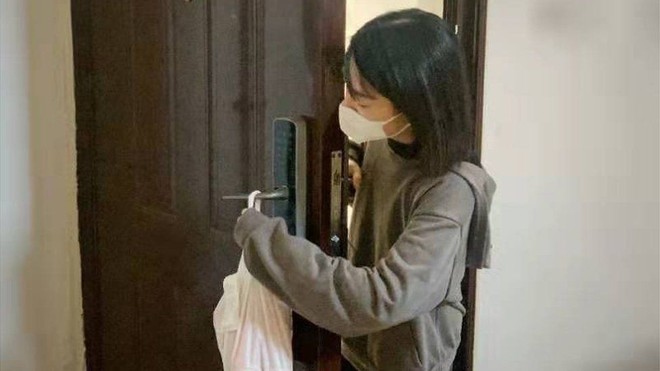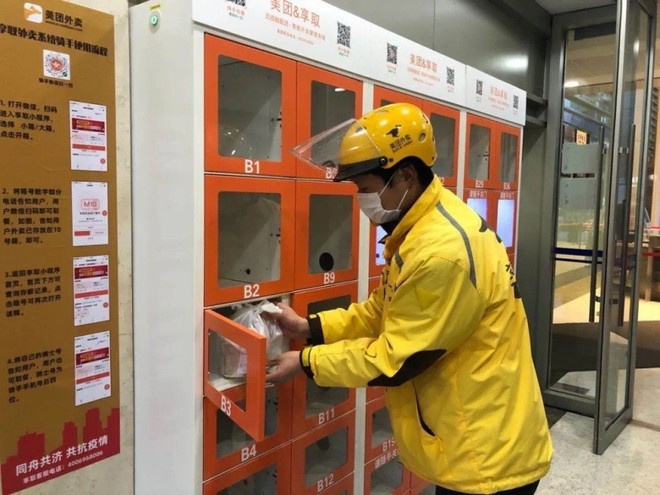Various forms of contactless delivery in China
- Tram Ho
Due to the infectious nature of Covid-19, China’s National Health Commission soon advised people to limit contact when receiving goods. At the peak of the epidemic, more than half of the country’s population – about 760 million people – lived in various levels of blockade. It is at this time that the huge e-commerce infrastructure comes into play. No matter where people live, their orders can be delivered in about 20 minutes for food, groceries and a few hours for other types of mail.
Of course, at the beginning of the epidemic, China’s delivery giants also faced difficulties when many cities were closed, factories stopped working, transportation, employees could not return to the office due to illness. stuck since Lunar New Year. Residents in small cities face long waits as some roads are blocked.

The delivery man hangs the goods outside the door of the customer’s house. (Photo: Meituan)
However, they still have many advantages that other countries do not have. Most importantly, most Chinese consumers shop through apps. In 2019, the online retail market here was worth nearly $2 billion, according to eMarketer statistics, accounting for nearly 35.3% of total retail sales, higher than any other country in the world. Their system can handle a large amount of demand at the same time at a normal time.
 The employee card clearly states the temperature of the food processor and delivery staff. (Photo: Meituan) |
| To help customers and employees deliver during the epidemic season, Chinese businesses are introducing a contactless model, whereby orders will be placed at the door of a home, in a locker or at a pre-agreed point during the pandemic. residential area, office. Some delivery apps go even further when providing information about the temperature of the chef or delivery staff. |
Fresh food platform Missfresh also built a storage area in large residential communities for people to pick up their order. Meanwhile, fast food chains such as KFC, Pizza Hut … announce that delivery staff will wait until customers appear before taking food out of the bag (in case of cold food) and placing it at one point. Then, they step back and wait at least 2m away, while the customer picks up and leaves. The payment made via WeChat quickly.
Drivers comply with all epidemic prevention principles, regularly disinfect delivery bags, wash hands.
Major e-commerce and food delivery services are also investing heavily in warehouse automation, delivery drones, and delivery robots. These moves are meant to reduce costs in the long run and help the company better withstand a labor shortage. According to Yu Enyuan, founder of unmanned delivery service Neolix, people’s perception of drone delivery changed 180 degrees during the epidemic when they realized those vehicles could do dangerous work. instead of people.
The rate of online ordering in China is always high and constantly increasing, in part because Alibaba and JD.com have been so successful at integrating online and offline shopping experiences with logistics services, including making the most of the stores. retailers as order fulfillment centers.
The ecosystem of the big guys is completely connected. From electronic markets such as Taobao, Tmall to supermarket chain Freshippo, all share the same technology, logistics system, individual user ID. During the lockdown in Hubei, Freshippo handled the spike in demand by taking advantage of freight buses, dismantling retail gift boxes, and hiring thousands of retail and home workers. unemployment goods.
 Smart cabinets have the feature of bactericidal and heat preservation with food products. (Photo: Meituan) |
| According to Wang Zhibin, a researcher at the National Technical Laboratory for Logistics Information Technology, although the original reason consumers chose contactless delivery was to reduce the risk of infection through direct contact, the need Their demand for this type will lead to the growth of smart lockers. For example, at the beginning of the epidemic season, Meituan provided 1,000 free meals a day to medical workers in Wuhan, along with cooking ingredients. Smart cabinets are installed at hospitals across the city for staff to place orders in, then medical staff will unlock the cabinets with a QR code. The cabinet has the feature of automatic sterilization by ultraviolet rays and keeping heat. If there is no recipient within 12 hours, the cabinet will send a notification to the carrier. |
Mr. Wang said that contactless delivery is the natural evolution of the delivery industry, making the service more efficient and safer. He believes it will stimulate the development of smart cabinets, driverless vehicles in the future. According to the National Postal Administration of China, in 2019, there were more than 406,000 smart cabinets installed in major cities in China in 2019, up from 127,000 in 2018.
Source : Genk
